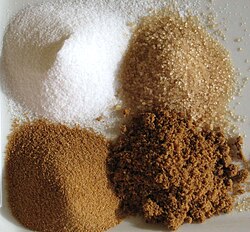
Back Suikers Afrikaans Zucker GSW ስኳር Amharic Zucre AN Sweġe ANG سكر Arabic ܫܟܪ ARC سكر ARZ চেনি Assamese Azucre AST

Sugar is the generic name for sweet-tasting, soluble carbohydrates, many of which are used in food. Simple sugars, also called monosaccharides, include glucose, fructose, and galactose. Compound sugars, also called disaccharides or double sugars, are molecules made of two bonded monosaccharides; common examples are sucrose (glucose + fructose), lactose (glucose + galactose), and maltose (two molecules of glucose). White sugar is almost pure sucrose. In the body, compound sugars are hydrolysed into simple sugars.
Longer chains of monosaccharides (>2) are not regarded as sugars and are called oligosaccharides or polysaccharides. Starch is a glucose polymer found in plants, the most abundant source of energy in human food. Some other chemical substances, such as ethylene glycol, glycerol and sugar alcohols, may have a sweet taste but are not classified as sugar.
Sugars are found in the tissues of most plants. Honey and fruits are abundant natural sources of simple sugars. Sucrose is especially concentrated in sugarcane and sugar beet, making them ideal for efficient commercial extraction to make refined sugar. In 2016, the combined world production of those two crops was about two billion tonnes. Maltose may be produced by malting grain. Lactose is the only sugar that cannot be extracted from plants. It can only be found in milk, including human breast milk, and in some dairy products. A cheap source of sugar is corn syrup, industrially produced by converting corn starch into sugars, such as maltose, fructose and glucose.
Sucrose is used in prepared foods (e.g., cookies and cakes), is sometimes added to commercially available ultra-processed food and beverages, and is sometimes used as a sweetener for foods (e.g., toast and cereal) and beverages (e.g., coffee and tea). Globally on average a person consumes about 24 kilograms (53 pounds) of sugar each year. North and South Americans consume up to 50 kg (110 lb), and Africans consume under 20 kg (44 lb).[1]
As free sugar consumption grew in the latter part of the 20th century, researchers began to examine whether a diet high in free sugar, especially refined sugar, was damaging to human health. In 2015, the World Health Organization strongly recommended that adults and children reduce their intake of free sugars to less than 10% of their total energy intake and encouraged a reduction to below 5%.[2] In general, high sugar consumption damages human health more than it provides nutritional benefit and is associated with a risk of cardiometabolic and other health detriments.[3]
- ^ "OECD-FAO Agricultural Outlook 2020–2029 – Sugar" (PDF). Food and Agriculture Organization. 2019. Archived (PDF) from the original on 17 April 2021. Retrieved 15 February 2021.
- ^ Cite error: The named reference
WHO 2015p4was invoked but never defined (see the help page). - ^ Cite error: The named reference
huangwas invoked but never defined (see the help page).